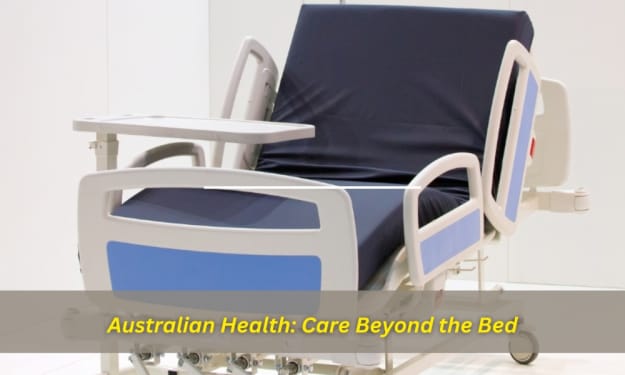Australian Health: Care Beyond the Bed
A Healthier Future: Beyond Hospital Walls

For nearly five decades, the idea of the healthcare system in Australia has been associated with hospital beds. However, a silent revolution is brewing, brought about by changes in the medical field and by the true spirit of the Australians. The use of hospital beds in Australia is one of many solutions to the healthcare sector's problems. This article looks closer at the wonders of getting ‘Care Beyond the Bed’ and how Australians proactively take charge of their health with new technologies and a focus on fitness. From home health care to talking about the magic of telemedicine, we will explore the emerging trends for the future of Australian health care, where Australians are on the move and can receive good health care wherever they are.
Beyond the walls: exploring alternative care options
This is the new life for a rising number of Australians due to the intervention of in-home care.
Tailored support: Home or Personalised Care entails services provided within clients' homes, including helping them with diabetes care and recovery after an operation.
Focus on well-being: A familiar home environment is very effective in helping a patient recover his or her mental and emotional health, consequently speeding up the recovery process.
Cost-effectiveness: Sicker patients needing continuous monitoring and complex treatments can be well-managed via in-home care, cheaper than hospital-confined patients.
Telehealth is another famous Australian practice in the ‘care beyond the bed’ revolution. This contradicts the tradition of being stuck in a traffic jam just to get a specialist appointment. In the current era, consultations, medical prescription reviews, and even, at times, remote patient monitoring do not necessarily require people to engage physically but are always at the tips of the fingers of certified health practitioners.
Tech to the rescue: optimising hospital bed usage
There is a focus on adopting new approaches to manage the allocation and utilisation of hospital beds.
Electronic Health Records (EHRs): These records offer an integrated electronic record of the patient's time and effectively facilitate care before, during, and after hospitalisations.
Real-time bed occupancy data: Emergency departments are also using real-time information concerning available beds within hospitals to enhance the distribution of resources. This helps minimise the time patients wait to be attended to and is a better way of planning for the other patients who are likely to visit the hospital.
Predictive analytics: Historical data and information about individual patients can be used to foresee the extent of bed deficiency in the future hospital and allocate resources adequately.
Such advancements include ensuring that hospital beds are not occupied by people when they can easily find an alternative and getting the beds to those who really require them.
The future of care: striking a balance
The question remains: Is investing more and more in building hospital beds the solution? Ending the speculation about one’s position on capacity, the truth would combine the two ideas. The future of Australian healthcare will likely involve a combination of:
Optimising existing resources: The two main factors in this category include technology and other care models to manage demand and hospital beds.
Investing in preventative healthcare: Promoting wellness and intervention before the onset of a health issue can drastically decrease hospital utilisation.
Government policies and funding: Future investments in structures and new care modes are crucial for a good-functioning healthcare system.
Ultimately, the aim is to provide all Australians with what they need: care in particular situations, not necessarily in a hospital bed.
Aussies on the move: staying active and healthy
As you have learned, activity, to some extent, helps prevent many conditions, so get out there and stay healthy! Be it in having a walk on the sand of the beach or barbecuing with friends; there are numerous activities that one can engage in to keep fit. Remember to check out resources from trusted organisations like the Department of Health.
To sum up, gentlemen and ladies out there, the progressive future of health care in Australia is a dynamic society filled with people on the move, able to oversee all the possibilities and continuously challenge the traditional notions of health care limited to a bed in a hospital. Through a bit of use of Australian stereotypes and innovation, along with a significant focus on utilising technology and a much more concentrated emphasis on primary care, we can construct a strong and reasonably sustainable healthcare delivery system in Australia.
The road ahead: challenges and opportunities
However, it is necessary to admit that the vision of professional liability is not without difficulties. Another challenge is meeting the requirements of delivering in-home care and other telehealth services to clients across Australia, including rural or remote areas. Moreover, due to the numerous types of funding in the healthcare sector, understanding one’s insurance policy is a challenge that some people find difficult to overcome.
However, it is also essential to understand that these obstacles can become new horizons for opportunities. Mobile clinics, such as those involving ambulatory motor vehicles and outreach and telehealth clinics, are helping those in remote areas get much-needed services. Also, including a focus on health promotion and prevention through the increase in cooperation between healthcare organisations, government institutions, and community organisations can provide better access to needed care and a more comprehensive focus on the population's health.
The Aussie advantage: A collaborative spirit
But one has to state that the attempt at creating the ethos of professional liability ‘beyond the bed’ is not without challenges. Another formidable challenge relates to meeting the needs of clients who require in-home care and other telehealth solutions across Australia and the country’s rural or remote regions. Furthermore, because there are myriad forms of funding in the healthcare segment, comprehending one’s insurance policy is difficult for some people.
But it is also necessary to realise that those barriers can become a new world of possibilities. Some forms of mobile clinics that are plateauing in these areas are outreach and telehealth clinics, which involve ambulatory motor vehicles. Also, social mobilisation, for example, increased cooperation between healthcare facilities, governmental and other organisations, and communities can improve the needed access to care and the scope of reference for the population's health.
Conclusion
The outlook for Australian health care is rosy. It is a future where Australians have autonomy over their health; it is a future characterised by innovative and technological advancements in the health field while maintaining a preventive-centred health system. The new concept's beauty goes well beyond conventional inpatient facilities and approaches healthcare delivery more holistically. This ‘care beyond the bed’ isn’t just about productivity; it’s about creating an active, healthy nation that can take on life’s journeys head-on. Therefore, whether you are getting back home from surgery or having a scheduled appointment with a specialist through telemedicine, know this: the future of Australia’s health sector is mobile, just like you.
About the Creator
Enjoyed the story? Support the Creator.
Subscribe for free to receive all their stories in your feed. You could also pledge your support or give them a one-off tip, letting them know you appreciate their work.





Comments
There are no comments for this story
Be the first to respond and start the conversation.